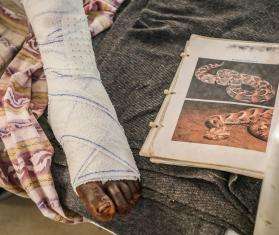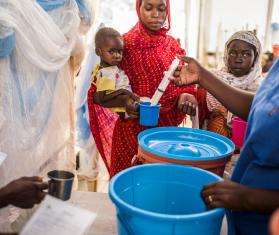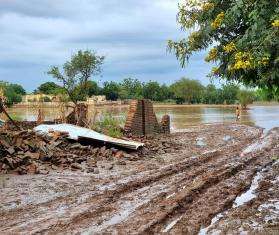An estimated 117 million people worldwide, or 1.5 percent of the global population, is forcibly displaced from their home, according to the UN Refugee Agency. Whether fleeing war, persecution, instability, or climate change and natural disasters, uprooted people face intense needs in their new surroundings.
Doctors Without Borders/Médecins Sans Frontières (MSF) serves the medical and mental health needs of refugees and other people on the move, regardless of their nationality, religion, political affiliation, or legal status.
To mark World Refugee Day, we outline below several of the countries and regions experiencing crises driving displacement.
1. Sudan
War and humanitarian catastrophe
The conflict that erupted between the Sudanese Armed Forces and the Rapid Support Forces in April 2023 has uprooted more than 9 million people, causing the world’s largest displacement crisis. Nearly 2 million people have fled to neighboring countries including Chad, South Sudan, Central African Republic, Egypt, and Ethiopia. This includes refugees and returnees—people returning to their country of origin after initially having fled to Sudan for refuge from previous conflicts in the region.

Many camps where refugees and displaced people are sheltering lack essential resources for the swelling number of residents. In Chad, many Sudanese refugees don’t have a reliable source of food, for example. In 2023, more than 1,500 patients, all under five years old, were admitted to an MSF nutrition program in Sila province for acute malnutrition.
In Adré, eastern Chad, MSF teams are treating people fleeing violence in neighboring El Geneina, the capital of Sudan’s West Darfur state. At Adré Hospital, we have 200 surgical beds and 30 maternity beds, and built an emergency field hospital out of inflatable tents. In Sila, also near the Chad-Sudan border, MSF operates an emergency project, and in Daguessa, MSF mobile clinics provide Chadian returnees with primary health care, including screening for malnutrition.
2. Libya
Abuse, arbitrary detention, and interceptions at sea
As of mid-June, at least 66,900 people have arrived in Europe via the Mediterranean Sea in 2024, with an estimated 631 missing or presumed dead, according to the UN Refugee Agency.
Libya is one of the main disembarkation points for boats making the Mediterranean Sea crossing. Many people seeking safety on European shores often have to wait in Libya for months or even years, saving up money to buy a boat ticket or trapped in arbitrary detention. Inside the detention centers, refugees, asylum seekers, and migrants have been assaulted, sexually abused, beaten, and killed. They have also been systematically deprived of the most basic humane living conditions, including sufficient access to food, water, sanitation, and medical care.

Many refugees and migrants crossing the Mediterranean are up against hostile European policies meant to discourage migration but have instead subjected them to riskier journeys. Since 2017, the EU and Italy have supplied, trained, and funded the Libyan Coast Guard to stop arrivals to Europe by forcibly returning people to Libya, where they face forced labor, indefinite detention, and extortion, as well as physical and sexual violence.
4. El Salvador, Guatemala, and Honduras
Extreme violence in the Northern Triangle
Each year, hundreds of thousands of people from El Salvador, Guatemala, and Honduras—a region known as the Northern Triangle of Central America—flee extreme violence and poverty and head north to find safety. The high levels of violence in the region are comparable to that in war zones where MSF has worked for decades.

Most people migrating from these countries pass through Mexico, in hopes of reaching the United States, but in cities along the US-Mexico border, inhumane US border policies and inadequate humanitarian responses from both US and Mexican governments have resulted in terrible conditions for people seeking safety.
MSF teams work throughout the Central American migration route, providing general medical care as well as mental health consultations to migrants and asylum seekers, including thousands of minors and survivors of sexual violence.
4. Myanmar and Bangladesh
Rohingya persecution and statelessness
The Rohingya are a refugee group faced with an additional challenge: statelessness. They are also one of the most persecuted ethnic minority groups in the world.
A 1982 law passed in Myanmar stripped the Rohingya minority of their citizenship after years of mass arrests, persecution, and horrific violence under Operation Dragon King, which drove hundreds of thousands of Rohingya across the border to Bangladesh.

MSF operates several projects providing care to Rohingya refugees in both Bangladesh and Myanmar. In Bangladesh, our teams working in the sprawling refugee camps of Cox’s Bazar are addressing rising rates of hepatitis C and the deterioration of people’s mental health due to poor conditions and movement restrictions. Nearly a million Rohingya now reside in Cox’s Bazar, which is the largest refugee camp in the world.
The Rohingya who remain in Myanmar also face severe movement restrictions. For Rohingya MSF staff, it takes months to be authorized to travel from between townships, because they need to receive a village administration verification, ward administration verification, police administration verification, and then often other authorizations from other authorities. On top of this, they must pay fees, and these fees are not the standard fees people with citizenship cards pay.




